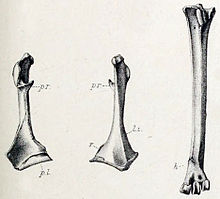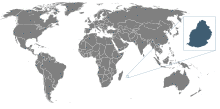| Mauritius night heron | |
|---|---|
 | |
| Subfossil remains | |
| Scientific classification | |
| Kingdom: | Animalia |
| Phylum: | Chordata |
| Class: | Aves |
| Order: | Pelecaniformes |
| Family: | Ardeidae |
| Genus: | Nycticorax |
| Species: | N. mauritianus |
| Binomial name | |
| Nycticorax mauritianus (Newton & Gadow, 1893) | |
 | |
| Location of Mauritius | |
The Mauritius night heron (Nycticorax mauritianus) is an extinct night heron species from Mauritius. It is only known by seven subfossil bone remains consisted of cranium, pelvis, coracoid, ulna, radius, and tarsometatarsus found in Mare aux Songes. Only the coracoid and the tarsometatarsus are left today. It was scientifically discussed in 1893 by Alfred Newton and Hans Gadow from the Cambridge University. Newton and Gadow measured the tarsometatarsus with 81 to 87 mm.[2] It became presumedly extinct in the late 17th century and was probably first mentioned by François Leguat in 1693 who described them as a "great flight of bitterns".
References
- ^ BirdLife International (2012). "Nycticorax mauritianus". IUCN Red List of Threatened Species. 2012. Retrieved 26 November 2013.
- ^ Greenway, James C. (1967): Extinct and Vanishing Birds of the World
